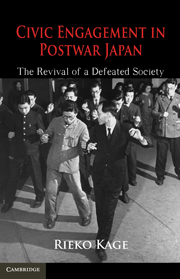Book contents
- Frontmatter
- Contents
- List of Tables
- List of Figures
- Preface
- Acknowledgments
- Civic Engagement in Postwar Japan
- 1 Introduction
- 2 Civic Engagement: The Dependent Variable
- 3 War and Civic Engagement: A Theoretical Framework
- 4 Quantitative Analysis: The Rise of Civic Engagement across Forty-Six Japanese Prefectures
- 5 The Long-Term Effects of Wartime Mobilization: Cross-National Analysis
- 6 Repression and Revival of the YMCA Japan
- 7 Wartime Endorsement and Postwar Repression of a Traditional Art
- 8 Civil Society and Reconstruction in Postwar Japan
- 9 Conclusions
- References
- Index
1 - Introduction
Published online by Cambridge University Press: 06 December 2010
- Frontmatter
- Contents
- List of Tables
- List of Figures
- Preface
- Acknowledgments
- Civic Engagement in Postwar Japan
- 1 Introduction
- 2 Civic Engagement: The Dependent Variable
- 3 War and Civic Engagement: A Theoretical Framework
- 4 Quantitative Analysis: The Rise of Civic Engagement across Forty-Six Japanese Prefectures
- 5 The Long-Term Effects of Wartime Mobilization: Cross-National Analysis
- 6 Repression and Revival of the YMCA Japan
- 7 Wartime Endorsement and Postwar Repression of a Traditional Art
- 8 Civil Society and Reconstruction in Postwar Japan
- 9 Conclusions
- References
- Index
Summary
OVERVIEW
War destroys. It claims lives, it damages economic and physical infrastructure, and it reduces opportunities for educational advancement. If a country is defeated, the citizenry inevitably is left traumatized as well. These are hardly conditions that would seem conducive to a growth and enrichment of civic engagement.
This book, however, finds considerable evidence that civic engagement rose dramatically in Japan after World War II and some initial evidence that it also rose in many other war-affected countries during the same period. The rise of civic engagement in Japan also notably predated the country's postwar economic takeoff. How could this be? This book seeks to explain the causes of the postwar growth in civic engagement. A standard explanation points to U.S. occupation policies, which democratized the Japanese regime and introduced freedom of association. But this explanation is inadequate; although the occupation regime removed barriers to civic engagement, it hardly forced Japanese citizens to participate in organizations. The civic space opened up by the occupation had to be filled by the citizens themselves.
The study proceeds in three steps. First, it documents the postwar surge in Japan's voluntary participation. Second, it takes a step back and offers a general theory of the growth in civic engagement in the wake of wars. Third, it tests the theory using both quantitative analyses of data from Japan and twelve other developed countries, as well as qualitative analyses of specific local associations in Japan.
- Type
- Chapter
- Information
- Civic Engagement in Postwar JapanThe Revival of a Defeated Society, pp. 1 - 18Publisher: Cambridge University PressPrint publication year: 2010

